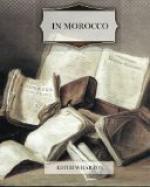Such is the twentieth-century curriculum of the University of Fez. Repetition is the rule of Arab education as it is of Arab ornament. The teaching of the University is based entirely on the mediaeval principle of mnemonics, and as there are no examinations, no degrees, no limits to the duration of any given course, nor is any disgrace attached to slowness in learning, it is not surprising that many students, coming as youths, linger by the fountain of Kairouiyin till their hair is gray. One well-known oulama has lately finished his studies after twenty-seven years at the University, and is justly proud of the length of his stay. The life of the scholar is easy, the way of knowledge is long, the contrast exquisite between the foul lanes and noisy bazaars outside and this cool heaven of learning. No wonder the students of Kairouiyin say with the tortoise, “Burn me rather than take me away.”
IV
EL ANDALOUS AND THE POTTERS’ FIELD
Outside the sacred precincts of Moulay Idriss and Kairouiyin, on the other side of the Oued Fez, lies El Andalous, the mosque which the Andalusian Moors built when they settled in Fez in the ninth century.
It stands apart from the bazaars, on higher ground, and though it is not horm we found it less easy to see than the more famous mosques, since the Christian loiterer in its doorways is more quickly noticed. The Fazi are not yet used to seeing unbelievers near their sacred places. It is only in the tumult and confusion of the souks that one can linger on the edge of the inner mysteries without becoming aware of attracting sullen looks, and my only impression of El Andalous is of a magnificent Almohad door and the rich blur of an interior in which there was no time to single out the details.
Turning from its forbidden and forbidding threshold we rode on through a poor quarter which leads to the great gate of Bab F’touh. Beyond the gate rises a dusty rocky slope extending to the outer walls—one of those grim intramural deserts that girdle Fez with desolation. This one is strewn with gravestones, not enclosed, but, as in most Moroccan cemeteries, simply cropping up like nettles between the rocks and out of the flaming dust. Here and there among the slabs rises a well-curb or a crumbling koubba. A solitary palm shoots up beside one of the shrines. And between the crowded graves the caravan trail crosses from the outer to the inner gate, and perpetual lines of camels and donkeys trample the dead a little deeper into the dusty earth.
This Bab F’touh cemetery is also a kind of fondak. Poor caravans camp there under the walls in a mire of offal and chicken-feathers and stripped date-branches prowled through by wolfish dogs and buzzed over by fat blue flies. Camel-drivers squat beside iron kettles over heaps of embers, sorcerers from the Sahara offer their amulets to negro women, peddlers with portable wooden booths sell greasy cakes that look as if they had been made out of the garbage of the caravans, and in and out among the unknown dead and sleeping saints circulates the squalid indifferent life of the living poor.




